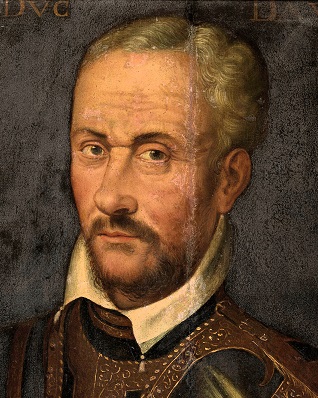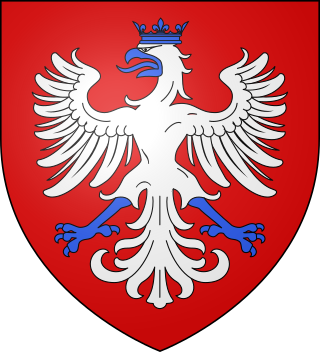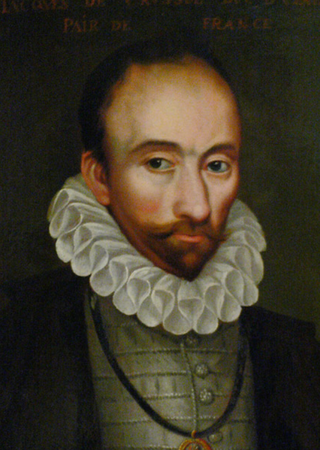
Poitiers is a city on the river Clain in west-central France. It is a commune and the capital of the Vienne department and the historical centre of Poitou. In 202, it had a population of 90,240. Its conurbation had 134,397 inhabitants in 2021 and is the centre of an urban area of 281,789 inhabitants. It is a city of art and history, still known as "Ville aux cent clochers".

Poitou was a province of west-central France whose capital city was Poitiers. Both Poitou and Poitiers are named after the Pictones Gallic tribe.

Charles IX was King of France from 1560 until his death in 1574. He ascended the French throne upon the death of his brother Francis II in 1560, and as such was the penultimate monarch of the House of Valois.

The French Wars of Religion were a series of civil wars between French Catholics and Protestants from 1562 to 1598. Between two and four million people died from violence, famine or disease directly caused by the conflict, and it severely damaged the power of the French monarchy. One of its most notorious episodes was the St. Bartholomew's Day massacre in 1572. The fighting ended with a compromise in 1598, when Henry of Navarre, who had converted to Catholicism in 1593, was proclaimed King Henry IV of France and issued the Edict of Nantes, which granted substantial rights and freedoms to the Huguenots. However, Catholics continued to disapprove of Protestants and of Henry, and his assassination in 1610 triggered a fresh round of Huguenot rebellions in the 1620s.

Poitou-Charentes was an administrative region on the southwest coast of France. It comprised four departments: Charente, Charente-Maritime, Deux-Sèvres and Vienne. It included the historical provinces of Angoumois, Aunis, Saintonge and Poitou.

Gaspard de Coligny, seigneur de Châtillon, was a French nobleman, Admiral of France, and Huguenot leader during the French Wars of Religion. He served under kings Francis I and Henry II during the Italian Wars, attaining great prominence both due to his military skill and his relationship with his uncle, the king's favourite Anne de Montmorency. During the reign of Francis II he converted to Protestantism, becoming a leading noble advocate for the Reformation during the early reign of Charles IX.

Claude II de Lorraine, duc d'Aumale was a Prince étranger, military commander and French governor, during the latter Italian Wars and the early French Wars of Religion. The son of the first Duke of Guise he started his career in a pre-eminent position in French politics as a son of one of the leading families in the court of Henri II of France. Upon the death of his father in 1550, Aumale inherited the governorship of Burgundy from his father, and the duchy of Aumale from his brother who assumed the titles of Guise. Aumale was made colonel-general of the light horse by the new king and fought in Italy, Alsace and Picardie between 1551 and 1559. While leading the light cavalry during the defence of Metz he was captured, and held for the next two years, until his mother in law Diane de Poitiers paid his ransom. He achieved success at the siege of Volpiano and played an important role in the capture of Calais for which he was rewarded with the governorship of French Piedmont.

The Peace of Saint-Germain-en-Laye was signed on 8 August 1570 by Charles IX of France, Gaspard II de Coligny and Jeanne d'Albret, and ended the 1568 to 1570 Third Civil War, part of the French Wars of Religion.

The Battle of Coutras, fought on 20 October 1587, was a major engagement in the French Religious Wars between a Huguenot (Protestant) army under Henry of Navarre and a royalist army led by Anne, Duke of Joyeuse. Henry of Navarre was victorious, and Joyeuse was killed while attempting to surrender.
The Battle of La Roche-l'Abeille occurred on 25 June 1569 between the Catholic forces of King Charles IX of France commanded by the Duke d’Anjou and the Huguenots commanded by the Admiral de Coligny during the "Third War" (1568–1570) of the French Wars of Religion.

François d'Andelot de Coligny was one of the leaders of French Protestantism during the French Wars of Religion. The son of Gaspard I de Coligny, he was the younger brother of Odet, cardinal de Châtillon and Gaspard de Coligny, the admiral.

The House of Coligny was the name of an old and important French noble family, originating from the Bresse region of France. The head of the family held the title Duke of Châtillon, created in 1643. Their bloodline ended in 1694.

Maixent Poitevin, was a 16th Century French squire and jurist.

Catherine de Parthenay, Viscountess and Princess of Rohan (1554–1631) was a French noblewoman, mathematician, philosopher, poet, playwright, and translator. She studied with the mathematician François Viète and was considered one of the most brilliant women of the era. De Parthenay was married twice, first to the Protestant baron Charles de Quelennec. During the four years of their marriage, Quelennec was often away and was reported to have dishonored his wife. After she reached out for support from Jeanne d'Albret, Queen of Navarre, he kidnapped and imprisoned her in a castle in Brittany. During the period that she was confined, her mother notified the Duke of Anjou, his mother Catherine de' Medici, and ultimately King Charles IX for resolution. Quelennec died soon after. She later married René II, Viscount of Rohan.
Events from the year 1569 in France.
The following is a timeline of the history of the city of Poitiers, France.

François III, Count of La Rochefoucauld, prince of Marcillac, count of Roucy and baron of Verteuil was a French courtier and soldier, serving as gentleman-in-ordinary to the king's chamber. He was a friend of Charles de Téligny and Louise de Coligny, serving as one of the witnesses to their marriage, whilst his humour and intelligence rendered him a favourite of Henry II of France and Charles IX of France. He is also notable as one of the Protestant leaders killed in the St. Bartholomew's Day massacre.

Jacques de Crussol, 2nd Duke of Uzès was a Protestant, then Catholic military commander and duke during the French Wars of Religion. Converting to Protestantism early due to the influence of his mother he would be acclaimed as defender of the Protestant church in Languedoc in early 1562. He would conduct a brutal campaign during the first civil war, capturing several towns and massacring their garrisons.

Guy de Daillon, comte du Lude was a French governor and military commander during the French Wars of Religion. The son of Jean de Daillon, governor of Poitou from 1543 to 1557, Lude inherited his position in the province, becoming governor shortly after his father's death. In 1560 the province, which had been a subsidiary governorship under the governorship of Guyenne was reconfigured to an autonomous entity, and given to Antoine of Navarre to buy his loyalty to the Guise regime. Resultingly Lude was given the role of lieutenant-general of the province instead of governor. However this was functionally a promotion as, when governor of Poitou previously he was subordinate to Navarre's authority in Guyenne. Now when Navarre was absent he had the powers of an autonomous governor.
Charles de Quelennec (1548–1572) was a French Protestant and the baron of Pont-l'Abbé, Brittany, France.
















